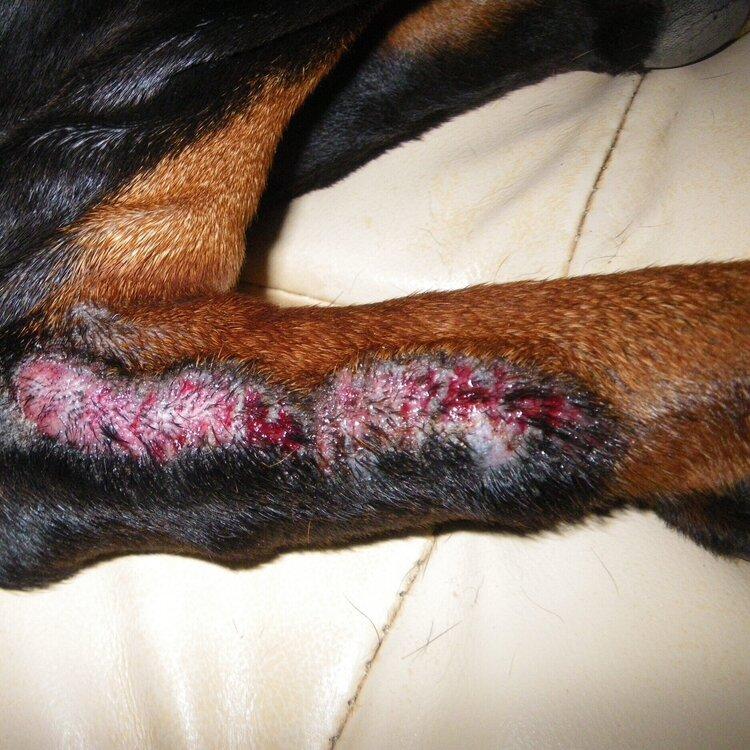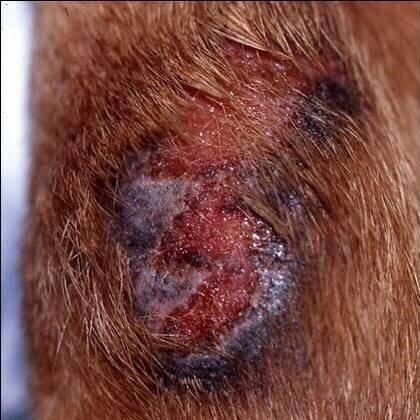Acral lick granuloma

Acral lick granuloma
Dog legs are typically the site of moist, fleshy, pink sores known as lick granulomas. They often result from an underlying condition that needs to be properly recognized and treated. They are produced by excessive licking at the location. You should consult a veterinarian right away if you think your dog may have a lick granuloma.
What is a lick granuloma?
A lick granuloma is a painful, red area of skin that develops as a result of your dog licking at the same spot over and over. The majority of lick granulomas develop at an accessible location for the dog; in most cases, this is the left foreleg since it is simple to reach when the dog is in a laying position. An underlying irritating condition is often the cause of many lick granulomas, but the itchiness usually manifests itself in a focused rather than a generalized way. In other situations, the licking could be a sign of pain (arthritis, for example, in senior dogs) that was brought on by a local trauma.
The dog licks the region after being initially stimulated, which causes infection and scarring. The area then gets itchy due to the damage already done, which makes the behavior self-perpetuating. Dogs with lick granulomas typically have deep infections, therefore a longer course of antibiotics is beneficial for them. It is believed that when a dog licks, endorphins—which are organic opiates that promote happiness—are released into the brain. The dog quickly discovers that licking produces this delightful sensation, so it continues to lick. A granuloma, a fleshy pink tumor, may form at the site as the procedure progresses. If the area is infected, it will often always be moist and may become especially red and swollen.
People who coexist with the dog may occasionally observe excessive licking of the afflicted area. But a lot of dogs only lick themselves when their owners aren't there.
What causes a lick granuloma?
An allergy or infection (such as ringworm) that produces itchy or painful skin is frequently the initial reason. But in certain dogs, the psychological component outweighs the initial factor. Lick granulomas tend to be more common in dogs that are anxious and tense, but they can also occur in dogs that spend a lot of time alone, get little exercise, or have low levels of mental stimulation.
-
ALD is multifactorial and can be frustrating to manage
-
ALD can affect dogs of any age, however large breed dogs are predisposed
-
Clinically present as well circumscribed, raised, alopecic, erosive to ulcerated plaques affecting the distal extremities. Neoplasia must be ruled out.
-
A primary factor is the inciting cause.
-
Primary factors include pruritus from allergic disease (atopic dermatitis, cutaneous adverse food reaction, flea allergy dermatitis), previous trauma, foreign body, dermatophytosis, demodicosis, bacterial and Malassezia infections and hormonal disease or pain from joint disease or osteoarthritis, or neuropathy.
-
Primary psychogenic factors include obsessive compulsive disorders, anxiety, boredom, stress or attention seeking behaviour.
-
A perpetuating factor causes the desire to continue to lick the granuloma. These include secondary bacterial infections, keratin foreign bodies, osteomyelitis and learned or compulsive disorders.
-
A combination of diagnostic and treatment options are required to both resolve and prevent the recurrence of ALG
Why has my dog got a lick granuloma?
Due to their protracted development, lick granulomas typically affect middle-aged or older dogs. Dogs of large breeds appear to be more likely to develop them. These individuals are overrepresented because endocrine and metabolic illnesses (e.g., decreased thyroid gland function) may also be the underlying cause. These diseases typically affect older large breed dogs. Dogs may lick a location initially due to an underlying issue (itchiness or discomfort), but eventually the practice becomes ingrained, and the dog only licks for pleasure.

How will my vet recognise a lick granuloma?
Lick granulomas appear as they usually do. Nonetheless, it is crucial to confirm that the sore is not a tumor before treating it as such because various illnesses, including infections and tumors, can mimic this appearance.
Why does my vet need to do other tests?
Your veterinarian should rule out any of the several underlying causes of lick granulomas since lick granulomas will keep coming back if an underlying cause is left untreated.
Can lick granulomas be treated?
For the therapy to be successful, the underlying reason must be correctly identified. It could be quite challenging to treat lick granulomas if the cause is not found. Treatment with antibiotics will be required to lessen tissue infection. It is common to take oral antibiotics for months at a time due to the severity of the infection.
The duration of therapy must be maintained for a minimum of four weeks following the resolution of all painful symptoms. A granuloma may be totally cured, but once treatment is discontinued, there is always a chance that it will return. Certain veterinarians advise applying lotions directly into the area; those that contain local anesthetics may assist to lessen the urge to lick. Aversives such as bitter apple can be applied to reduce licking. As an alternative, medications that obstruct neuropeptide transmission—which is crucial for the transmission of pain and itching—can be applied. The active component of chili peppers, capsaicin, can be applied topically to the granuloma's margin.
Licking the sore spot releases endorphins, which are natural compounds that have a morphine-like effect and give the dog a positive feeling, which is one of the reasons the dog keeps licking the spot. Administering an opioid medication, such as hydrocodone, to certain dogs can help them feel less irritated and possibly meet their endorphin needs.
In extreme situations, one may need to resort to drastic procedures like surgically excising the sore. In addition, surgical wounds may not heal properly, and if the dog begins to lick the sutures, you can find yourself in a worse situation than you were before the procedure. Before starting any treatment, you should carefully consider your alternatives and make sure you have talked to your veterinarian about them all.
What can I do to prevent lick granulomas recurring?
It is imperative to address underlying allergies or endocrine problems in many dogs in order to both ensure clearance of the current granuloma and prevent its recurrence. It's also critical to treat any potential psychological issues, as some cases may improve with little environmental adjustments (like lowering stress or boredom). Increasing exercise, training, and companionship for the dog can all help reduce boredom. Antidepressants with mood-altering properties, including Prozac or amytriptiline, have been recommended in more severe situations. Acupuncture has been reported to have some success stories.
Treatment for acral lick granulomas is quite frustrating. There is no easy solution, and the owner and veterinarian must work together to take a committed and persistent approach to success.



